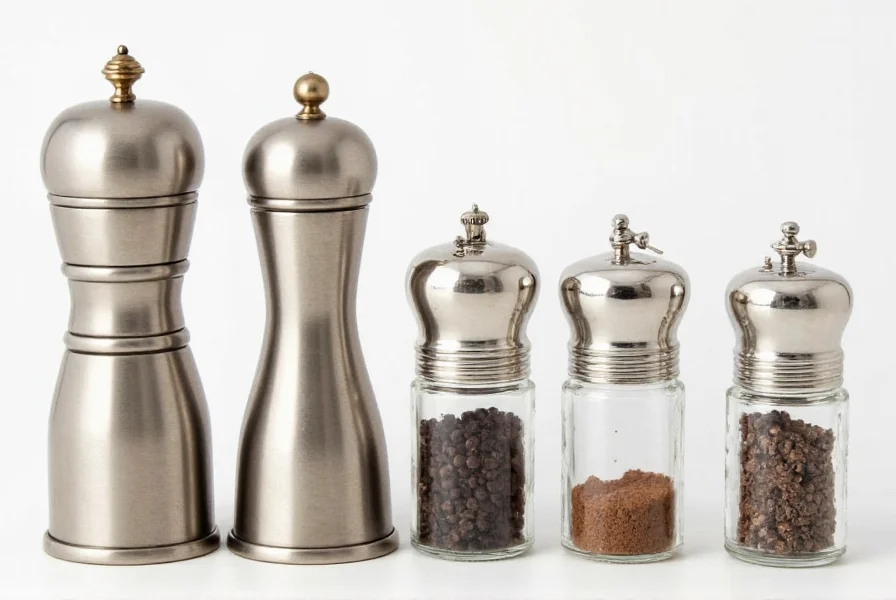Choosing appropriate salt and pepper containers significantly impacts your cooking experience and seasoning preservation. Unlike generic storage solutions, purpose-built containers address the unique properties of these essential seasonings. Salt requires moisture-resistant materials and precise dispensing mechanisms, while pepper benefits from adjustable grinding systems that preserve essential oils and flavor compounds.
Understanding Salt and Pepper Container Types
The fundamental distinction lies between shakers and grinders. Salt typically uses shaker-style containers with multiple small holes, while pepper requires grinding mechanisms to break down whole peppercorns. This difference stems from their physical properties—salt is usually fine and dry, whereas pepper comes as whole berries needing mechanical breakdown.

Materials Matter: Choosing the Right Construction
Material selection directly affects performance and longevity. Consider these common options:
| Material | Best For | Considerations |
|---|---|---|
| Stainless Steel | Pepper mills | Resists corrosion, maintains sharp grinding mechanism, but can transfer metallic taste to salt |
| Acrylic | Salt shakers | Moisture-resistant, transparent for visibility, but may discolor over time |
| Ceramic | Both seasonings | Attractive, non-reactive, but fragile and heavier than other options |
| Wood | Pepper mills | Natural aesthetic, but requires maintenance and shouldn't be used for salt |
Key Features to Consider When Selecting Containers
When evaluating best salt and pepper containers for home use, prioritize these functional elements:
- Adjustable grind settings - Essential for pepper mills to control coarseness from fine powder to coarse cracks
- Moisture protection - Salt containers need tight seals to prevent clumping in humid environments
- Ease of filling - Wide openings or removable tops simplify refilling without spills
- Dispensing precision - The right number and size of holes ensures controlled seasoning application
- Capacity - Match container size to your usage frequency to maintain freshness
Why Salt and Pepper Containers Differ in Design
Understanding why glass salt and pepper shakers often differ reveals important functional considerations. Salt's hygroscopic nature (attracting moisture) requires different engineering than pepper's needs. Salt containers typically feature:
- Fewer, smaller holes to prevent clumping and over-dispensing
- Non-metallic components to avoid corrosion
- Tighter seals to protect against humidity
Pepper containers, by contrast, need:
- Grinding mechanisms that preserve essential oils
- Larger openings for whole peppercorns
- Adjustable settings for different grind sizes

Maintenance Tips for Long-Lasting Performance
Proper care extends the life of your salt and pepper containers. For maintaining salt and pepper grinders:
- Clean salt shakers monthly with warm water and mild soap, ensuring complete drying before refilling
- Never immerse wooden pepper mills in water—wipe with a damp cloth instead
- Replace grinding mechanisms in pepper mills when performance declines
- Store containers with seasoning inside in a cool, dry place away from direct sunlight
- Use rice grains in salt containers in humid climates to absorb excess moisture
Avoiding Common Selection Mistakes
Many home cooks make these errors when choosing salt and pepper containers:
- Using the same container type for both seasonings despite their different requirements
- Selecting decorative containers without considering functionality
- Ignoring the importance of proper sealing for salt preservation
- Choosing containers that are difficult to clean or refill
- Overlooking the impact of material on seasoning quality and taste
Remember that the best salt and pepper containers balance aesthetics with practical functionality. Well-designed containers make seasoning food more precise and enjoyable while preserving the quality of your ingredients.
Frequently Asked Questions
Can I use the same container for both salt and pepper?
While possible, it's not recommended. Salt and pepper have different physical properties requiring specialized containers. Salt needs moisture protection and precise dispensing holes, while pepper requires grinding mechanisms. Using dedicated containers preserves flavor and ensures proper functionality for each seasoning.
Why does my salt shaker keep clogging?
Salt clogging typically occurs due to moisture absorption. To prevent this, ensure your salt container has an airtight seal, consider adding a few grains of rice to absorb humidity, and avoid storing near steam sources like dishwashers or stovetops. Using coarse salt varieties can also reduce clumping in humid environments.
How often should I replace my pepper grinder mechanism?
Pepper grinder mechanisms typically last 1-3 years with regular use before losing effectiveness. Signs it's time for replacement include inconsistent grinding, difficulty turning the mechanism, or pepper passing through without being ground. Stainless steel mechanisms generally outlast ceramic ones, especially with frequent use.
What's the ideal size for salt and pepper containers?
The ideal size depends on your usage frequency. For daily cooking, 4-6 ounce containers provide enough capacity without compromising freshness. Smaller 2-3 ounce containers work well for occasional use or as travel sets. Consider your storage space and how often you're willing to refill when selecting size—larger isn't always better for seasoning freshness.
Are wooden pepper mills better than metal ones?
Wooden mills offer aesthetic appeal and don't transfer temperature like metal, potentially preserving pepper oils better. However, metal mills typically feature more durable grinding mechanisms and precise adjustment. The best choice depends on your priorities—wood for traditional aesthetics and natural insulation, metal for durability and consistent grinding performance.











 浙公网安备
33010002000092号
浙公网安备
33010002000092号 浙B2-20120091-4
浙B2-20120091-4